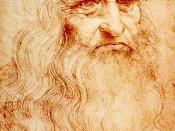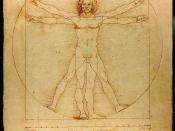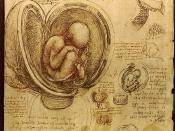To better explain and tell about the Renaissance period, we have to give the explanation of what the Renaissance means. Renaissance is a rebirth of a culture. It occurred in Europe from about the fourteenth through the middle of the seventeenth centuries. Renaissance was based on rediscovery of the literature, art, music and architecture of ancient Greece and Rome. People at that time saw Rome as the base of the civilization. And the important part is that America was discovered at that time, and the reformation began. During the renaissance, the change occurred in everything: in music, literature, art, and architecture. The major shift was from the communal to the individual. The power was also taken away from the church and toward a secular government. It was a period of exploration and adventure. It was also an age of curiosity and individualism. Everything was focused on human life and its accomplishments.
With the fall of Roman Empire, the Enlightment came. It happened about 476 AD. The city of Rome was attacked by Barbarians from Germany. Even though Emperor Constantine made Christianity a state religion, the Rome fell little by little. The Catholic Church was far less powerful during the Renaissance than it had been during the Middle Ages. That is when the Protestant Reformation began led by Martin Luther in 1483-1546. The church no longer monopolized learning. The upper classes and aristocrats thought that education was considered a status other than the necessity. They hired teachers to teach their own children. A little before, the books were copied by hands, and were very expensive. But with the Renaissance, the invention of the printing helped to publish the books needed to teach the children. Overall, Renaissance brought a lot of changes into the world in every aspect of it.
Renaissance was also a rebirth of art. There were three different parts in the Renaissance: early renaissance (1425-1500), Renaissance and Mannerism (1480-1600), and Baroque (1600-1700). Gothic era was a transition between the Middle Ages to the Renaissance. Humanism strongly influenced art throughout the Renaissance period. The high point was reached in frescos and panel paintings. Painters and sculptors were attracted to subjects drawn from classical literature and mythology. Classical mythology was an important source of inspiration for Renaissance art. They once again depicted the nude human body, a favorite theme of antiquity, but an object of shame during the Middle Ages. Medieval painters were more concerned about the religious paintings, other than the beauty of God's creation. On contrary, the Renaissance painters like the famous Leonardo da Vinci and Raphael, were more interested in the real people. They used linear perspective, balance, and a geometrical system that helped them to create an illusion of space and depth. The paintings looked clearer than in the Medieval Era. Backgrounds looked real, not like a foil with figures taped on it. The Virgin Mary was no longer created like a childlike creature, but like a beautiful, idealized young woman. And if something was enclosed in a circle, it was always considered perfection. During Renaissance, the oil paint also started to be used. It gave a shine to a picture, and more layers could have been put on. The artists were not allowed to sign their work. But the famous Michelangelo did it anyway. On the sculpture named Pieta, he signed his name on Mary's robe. Different artists had performed their work differently. In the beginning of the Renaissance, the pictures look different than the ones later in the century. In Botticelli's work, the distinction can be seen easily. The hair on the paintings always is in clumps, and it is wavy. The second toe is always bigger than the first one, and in all of his paintings, woman have like a dreamy look on their face. In Jan Van Eyck, Eve looks like she is pregnant. She is also holding a piece of fruit in her had for the emphasis on the way that she had sinned before God. The sculptors were very talented at that time. Michelangelo did a lot of good art works. The famous one is a sculpture of David. The Pieta is also known almost everywhere. The ceilings in the chapels and in churches were painted by the famous painters also. The Sistine Chapel is a piece of art, Notre Dame de Paris, and Cathedral of Chartres. The flying buttresses were used in the churches and Cathedrals because they were light, and that way the Cathedral walls were high and thin, and were able to be decorated with paintings, and stained-glass windows. Later in the Renaissance, the art work was beginning to be worshiped, and the chapels and churches were not decorated anymore, and the art work kind of stopped for a while. The most famous Renaissance painters were Sandro Botticelli, Jan Van Eyck, Leonardo da Vinci, Buonarrati Michelangelo, Raphael, Rembrandt, Vermeer and others.
Literature declined during the Middle Ages, but it rose back up again during the Renaissance period. A lot of magnificent work was written at that time that we still read and enjoy. William Shakespeare was a brilliant English poet and playwright. He was considered the best poet in England at that time. Shakespeare was very good at what he wrote, and he was good at writing in blank verse. He wrote a lot of plays, more than a hundred and fifty sonnets. People still used a lot of his sayings and quotations. He was born in Stratford, and he spent most of his life in England where he built his career. Some of his best plays are Hamlet, Romeo and Juliet, King Lear, Julius Caesar, Othello, a comedy Much Ado About Nothing, and others. The other known writer is John Milton. He was famous not only for his work, but for the time that he spent in jail because of his politically written allegories. Later in his life he also lost his eye sight, and went completely blind. He revived the Roman and Greek poetry. Milton took the ancient form of Roman epic and transformed it into a wonderful famous piece called "Paradise Lost". In it he took the mythology and mixed it with stories from a Bible. The story is about Adam and Eve, and the Satan. But the Satan is a hero in his story, just the opposite from the Bible. Shakespeare and Milton were the two major writers at that time, and we still read their beautiful work.
The Renaissance in music occurred between 1450 and 1600. The invention of printing also widened the circulation of music, and the number of composers and performers increased. Every educated person at that time was expected to be trained in music. As in the past, musicians worked in the churches, courts and towns. Church choirs also grew in size. During the Middle Ages, church music was sung by several soloists, but during the Renaissance it was performed by an entire male choir. Although the church remained an important key in music, musical activity gradually shifted to the courts. A court music director would compose secular pieces to entertain the noble class, and sacred music for the court chapel. Composers had no longer to stay unknown; they got credit for their work. During the Renaissance, the vocal music was more important than the instrumental music. Composers wrote music to enhance the meaning and emotion of the text. Renaissance musicians often used musical representation of specific poetic images. Renaissance music sounds fuller than medieval music. The pitch range was expended to more than 4 octaves, and richer harmony came with it. Before that, a line was added on top of the other, with little attention to the harmony. Renaissance music sounds calm and relaxed, because stable chords are played more. And the rhythm is a gentle flow, not a sharp beat. During the Renaissance, secular music became very important and popular. Secular music was written for groups of solo voices and for solo voice with the accompaniment of one or more instruments. Baroque style was shaped by the needs of churches, which used the emotional and other qualities of art to make worship more attractive and appealing. The middle class also influenced the development of the baroque music. The baroque style flourished during the period from 1600 to 1750. The two major composers were George F. Handel, Johann S. Bach, and Antonio Vivaldi. The main keyboard instruments at that time were organ and harpsichord. A baroque piece usually expresses one basic mood: if it begins joyfully, than it will end joyfully. Rhythmic patterns heard at the beginning of a piece were repeated throughout the whole part. There also was an alteration between loud and soft sounds. In the middle of the baroque period, scales gradually gave way to major and minor scales. And instrumental music also became important. Many compositions were written for specific instruments, and the violin was most popular. As we know today, music was very important at that time and because of the great work that people did, we still have a lot of beautiful music to enjoy.
Renaissance was and is a very important period in the history. A lot of changes occurred at that time, and what we have today is all because of the work people did, and the sacrifices they made for that.



Oh dear....
"Even though he was born in Stratford, he spent most of his life in England "
Stratford is IN England!
You should avail yourself of Cheathouse's spellcheck, although that won't help sentences like "Shakespeare was very god".
3 out of 6 people found this comment useful.